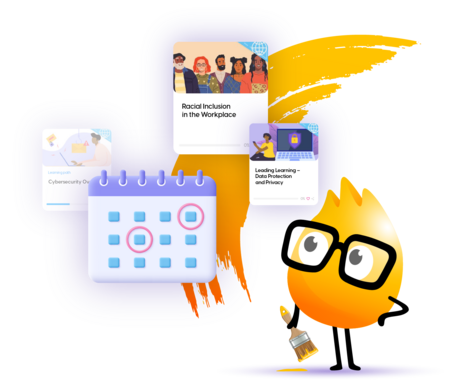Sales Onboarding ROI: Beyond Ramp Time
A strong sales onboarding program isn’t an easy thing to maintain. It’s lengthy, costly, and has to be updated regularly to accommodate the changing market. A recent report shows that it takes an average of 38 days and costs an average of $9,589 to onboard a salesperson.
With that sort of investment, decision-makers often want to know exactly what they’re getting back from their sales onboarding program. What is the return on investment (ROI) of sales onboarding?
The answer might surprise you. A strong onboarding program gives a lot back to a sales organization. The operative word here is “strong.” If a company doesn’t invest in proper sales onboarding, they don’t see results. That might give decision-makers the impression that onboarding isn’t worth any investment, but nothing could be further from the truth.
Ramp time: a great ROI metric, but not the only metric
When we talk about sales onboarding, the focus is often on improving just one metric: ramp time. The accepted wisdom says that it takes an average of three months for a new rep to start hitting sales targets. However, other research finds that it takes nine months for new reps to be competent and 15 months to become a top performer. For longer sales cycles, ramp time could be even longer.
There is ample evidence that a solid onboarding program improves ramp time; one study shows that onboarding cuts ramp time by 50%, while another found that onboarding improves win rates by 14% and quota attainment by 6.6%.
However, a solid onboarding program does much more than simply decrease ramp time. When you invest in onboarding, you’re also boosting retention, morale, and productivity.
What is the ROI of sales onboarding?
Learning and Development (L&D) professionals don’t love having to prove ROI — it can be hard to draw a direct line between training and profit — but training has been shown to produce more revenue.
According to research, every dollar a company invests in training generates about $4.53 in return. That’s an ROI of 353%. Aside from the hard numbers, there are several other business areas in which the ROI of onboarding can be felt, and more importantly, measured.
Improved productivity
A strong onboarding program gives your reps the tools, knowledge, and support they need to be great at their jobs. The numbers bear this out; a standard onboarding program results in 54% more productivity from new hires. Additionally, data shows that organizations with intense onboarding programs are up to 15 times more likely to have reps who generate pipeline faster.
This is the result of onboarding programs that help new hires understand their roles and responsibilities, so that they know exactly what they’re supposed to do as soon as they are put in front of a customer.
Sales team retention
There has been a labor crisis in sales. Salespeople rarely stay at the same job for long and replacing them is expensive; it costs more than $200,000 to replace a high performer and it can take more than four months to replace any rep. Reps have always moved between jobs, but they’re job-hopping even more now —more than half of sales leaders say that their staff is turning over much faster than it did pre-pandemic. Only 60% of sales hires stay with the company for at least six months, meaning that companies are in a constant cycle of hiring and training talent.
A strong sales onboarding program can make all the difference; 69% of employees are more likely to stay with an organization for at least three years after a great onboarding experience. Why? Sales is hard, and it’s gotten more difficult recently. Customer expectations are higher than ever, and selling techniques have changed. By providing reps with the support they need to do their jobs well, you can keep them from looking elsewhere.
Vetting through onboarding
The last thing an organization wants is to sink a lot of investment into a salesperson who isn’t up to par. While learning and training can improve a rep’s performance it’s also used by 78% of sales leaders to weed out hires who aren’t a good fit for their team.
A strong onboarding program can act as a test drive, giving the salesperson a taste of the organization, and a sales manager an idea of their new hire’s capabilities. If the new hire doesn’t seem right for the job, the manager can let them go before they’ve spent money and time training them.
Improved morale
Sales onboarding is about more than the sales process, paperwork, and other basics. It’s also a chance to bond with your new hires, to induct them into the company culture, and to create a sense of belonging. Research shows that salespeople who’ve undergone a robust onboarding program are 18 times more committed to their organizations.
The necessity of sales onboarding
Despite the evidence, not all organizations invest in sales onboarding, and some don’t onboard at all. One report found that 58% of companies focus their onboarding efforts on procedures and paperwork, rather than content that will help salespeople succeed at their jobs.
However, sending new hires into potential sales unprepared isn’t a good idea for anyone: for your employees, your company, or your customers. A solid onboarding lays the foundation for your new hires’ career at your company. It also gives them the tools to sell your product and keep your customers happy — two things that drive revenue.
Providing training and enablement for your salespeople starts with onboarding, but the most successful companies continuously train every member of their sales team – from new hires and entry-level sales reps, to experienced sales pros and seasoned sales. Is your organization meeting the training needs of every person on your sales team, regardless of how long they have been at the company, or how many years of experience they have? To gain insights on the best practices for boosting performance through continuous sales training, check out our latest eBook, Rev Up Revenue: Sales Training for Every Career Stage.





